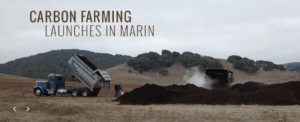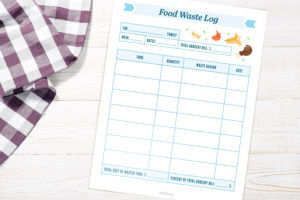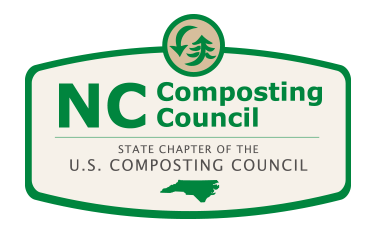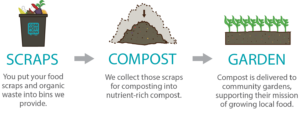
The Link Between Soil and CO2
Did you know that according to the US governments analysis of grassland ecosystems in the year 2000, only 3% of the tall grass prairie that was once in North America is still intact? This loss has had a huge impact on the way our entire ecosystem works, but what is little known is the massive loss of soil carbon that has accompanied the loss of prairie land. All of that carbon from the soil has been released into the atmosphere and is responsible for about one third of the increase in atmospheric CO2 over the last 150 years. Turning Earth, LLC says more carbon has gone into the atmosphere from the soil than from fossil fuel between 1860 and 1970.
Soil carbon and its impact on climate change is the subject of intensifying scientific research, and with good reason. The findings of current research are expanding our knowledge of how soil sequesters carbon and how our own effort to regenerate the soil with compost can slow down the rapid rise of CO2 in the atmosphere.
Overall, the world’s soil holds about three times as much carbon as the atmosphere and recognition of its capacity to take up atmospheric CO2 is catalyzing a significant shift in the direction of the battle against global warming. The focus thus far has been in quelling emissions from the burning of fossil fuels; however crucial that reduction may be, scientists now find that soil carbon sequestration, known as a carbon “sink”, is as a promising a weapon in the fight and one that can be utilized by everyone from large agricultural and governmental organizations to individual home owners.
According to Rattan Lal, Director of Ohio State University’s Carbon Management and Sequestration Center, the world’s soils have lost between 50% and 70% of their original carbon stock, much of which oxidized when exposed to air, becoming CO2 when the soil was cultivated. Places like the North American prairie, the North China Plan and even the arid interior of Australia are now being considered future carbon sinks based on the rapidly expanding knowledge of carbon sequestration in soils. Researchers are studying how land restoration projects in these areas might bring back carbon, nitrogen and, thereby, the natural fertility these areas have lost. “We cannot feed people if soil is degraded,” Lal says.
When soil is tilled or disturbed in any way the carbon in it is exposed to the air, an oxygen source. The carbon atoms attach to the oxygen forming CO2 a potent greenhouse gas. Conventional farming practices continuously remove plant material that has grown each season that, in the natural system, would return to the soil when the plant dies. In countries like India farmers literally burn the dead plant material off the fields in order to clear the land for the next planting. Besides putting harmful smoke into the air, these intensive farming practices remove further carbon from the soil adding to the deterioration that has been rampant throughout the world for decades.
Regenerative agricultural practices like no till farming, planting of “green manure” cover crops, and top dressing the field with compost can turn back the carbon clock, reducing atmospheric CO2 while raising soil fertility and decreasing vulnerability to floods and drought.
“The nation that destroys its soil, destroys itself” -Franklin Delano Roosevelt
Plants pull carbon out of the air through photosynthesis forming carbon compounds that are the structure of the plant body itself or biomass. What the plant doesn’t need for growth is secreted through the roots and becomes food for soil organisms like microbes and fungi. This is known as the humification of carbon, a process in which the carbon is made stable in the soil. Humus, whose main component is carbon, gives soil the ability to hold water, determines its structure, and gives it fertility.
Lal estimates the potential to store carbon in the top layer of degraded and desertified soils around the world could amount to 1 – 3 billion tons of carbon annually, equal to approximately 3.5 to 11 billion tons of CO2 emissions. Active soil carbon which is located in the topsoil (generally the top 15 to 30 centimeters) is continually exchanging carbon between microbes living in the soil and the atmosphere. Bolstering soil microbiology by adding compost restores normal soil activity in places where it has been interrupted by the use of insecticides, herbicides, or fertilizers.
It is currently unknown how much carbon is stored in deep carbon pools well below the active layer of soil, it is thought that soil below the five meter depth may store carbon at much higher rates than shallower soils. Encouraging finding are coming in from scientists studying some deep rooted grasses in Australia with below-ground plant structures that plunge more than five meters deep sequestering carbon all the way down.

The Marin Carbon Project
The Marin Carbon Project was started in 2007 when local farmers concerned about the impact of global climate change on the productivity of their farms. Located in the San Francisco Bay Area the group now includes farmers, researchers, government agencies, and nonprofits who are working to enhance soil carbon sequestration in farm land, range land, and forests. The aim is to improve farm productivity and the health of the local ecosystem while mitigating climate change. Citing research that showed dairy farms had more carbon in their soils than the adjacent grasslands because farmers sprayed manure on fields as a way of recycling the waste. This group believed that they could improve soil quality and offset CO2 emissions produced by agriculture by putting compost on grasslands.
Lead by researcher Whendee Silver of the University of California at Berkley, the Marin Carbon Project showed that applying composted agricultural and green waste to grasslands sequesters carbon at a rate of 1 metric ton per year. The fields that the project treated with compost also had higher forage production due to higher fertility and better ability to hold water in the soil. The conclusion after nine years of steady results is that applying organic matter to soils is one of the most effective ways currently available to divert CO2 from the atmosphere.
According to the Food and Agriculture Organization of the United Nations, grasslands comprise 40.5% of the earth’s terrestrial area excluding Greenland and Antarctica. The use of chemicals that kill soil microbes and fungi, overgrazing, erosion, fires and simple poor land management have robbed of much of this land of its carbon and carbon-storing ability.
Expanding the practices of the Marin Project to just 25% of California’s grasslands, Silver projects that the carbon sequestration rate would be 21 million metric tons of carbon per year. Grasslands, farm lands and uninhabited lands, with the addition of compost, could return carbon to the soil, reduce greenhouse gas emissions and divert green waste from landfills.

 Print out this food saver cheat sheet with strategies on storing more than 20 common foods to maximize freshness.
Print out this food saver cheat sheet with strategies on storing more than 20 common foods to maximize freshness. 
![]()











